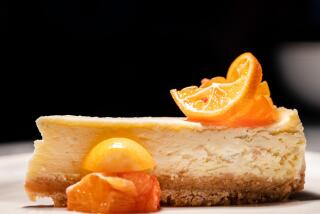Pie for Dinner: The Mediterranean Pleasure
The noted French chef Careme pronounced the vegetable torte well and truly dead by the first part of the 19th century.
“Tortes are no longer fancy enough to appear on our opulent tables, for the simple reason that their form is too vulgar,” he wrote in “Treatise on Hot Entrees.” “Even the bourgeois class looks upon them with disdain, and will only eat hot pates and vol-au-vents, whereas in the past, important people were happy to begin their home-cooked meal with a modest torte.”
He may have jumped the gun. I don’t think I’ve ever gone to a Mediterranean country--France or anyplace else--and not come home with a new recipe for one of these savory pies.
Throughout the Mediterranean you find variations. Usually, they’re based on the same vegetable themes--greens of all kinds, winter or summer squash, leeks, eggplant, onions. What really distinguishes one country’s pies from another are the fine points, the flavorings, the cheeses and the crusts.
A winter squash torte from Provence, earthy with sage and surrounded by a bready olive oil crust, would never be mistaken for a Greek pumpkin torte, the filling redolent with mint and leeks, set between layers of crisp filo dough.
At the same time, a Greek pie of spinach or bitter greens will be fragrant with dill and packed with feta cheese, while its French or Italian cousin will have a more moderate amount of Gruyere and/or Parmesan, as well as garlic, thyme, rosemary and parsley.
Tortes take a little bit of time to make, but they are forgiving. And you can make them in steps. The order in which you do things isn’t that important--you can make part or all of a filling one day, and the crust another (or vice versa), and put it all together when you’re ready to bake.
Because they keep so well, they also can be made ahead, or frozen. If you do the whole thing, from start to finish, you’ll be working for about an hour, but none of the work will be that difficult. The yeasted olive oil crust is about the easiest pastry I’ve ever made.
Best of all, they’re big, dramatic and versatile. You can make them in a tart or springform pan, as a double-crusted torte, or you can make a more open-faced galette and bake it on a cookie sheet. They are meant to be served as a main dish, and they’re good hot or cold.
Tortes make great party fare, but they’re also a wonderful meal for the family; and leftovers pack easily into a lunchbox. This is one way I can get my 3 1/2-year-old to eat spinach. Of course, he hasn’t read Careme yet.
*
Greek Winter Squash and Leek Pie
Active Work Time: 35 minutes * Total Preparation Time: 1 1/2 hours * Vegetarian
2 1/2 pounds winter squash, such as 1 large or 2 smaller butternut squash
1/2 cup chopped Italian parsley
1/4 cup chopped fresh mint
1/4 teaspoon freshly grated nutmeg
1 cup crumbled feta cheese (about 5 ounces)
1/2 cup grated Parmesan cheese (2 ounces)
3 tablespoons olive oil, divided, plus 3 to 4 tablespoons for brushing filo dough
3 large leeks, white and light green parts only, cleaned and chopped
2 large cloves garlic, minced or pressed
3 eggs
Salt
Freshly ground pepper
9 sheets filo dough
Halve the squash and scrape away the seeds and membranes, then cut the flesh into 4-inch-square pieces. (If using butternut, cut it in half crosswise just above the bulbous bottom part, then cut these halves into lengthwise quarters and scrape away the seeds and membranes.)
Steam the squash until tender, 15 to 20 minutes, then transfer to a colander and allow to cool and drain for another 15 minutes (butternut squash will not be watery). When the squash has cooled, peel and place in a bowl. Mash it with a fork, a large wooden spoon, a potato masher or a pestle. Stir in the parsley, mint, nutmeg, feta and Parmesan.
Heat the oven to 375 degrees. Heat 2 tablespoons of olive oil in a large nonstick skillet over medium heat and add the leeks. Cook, stirring, until tender and just beginning to color, about 5 to 10 minutes. Add the garlic and continue to cook for another minute, until fragrant. Remove from the heat and add to the squash. Beat the eggs and remove 2 tablespoons for brushing the tart, then mix with the squash. Season to taste with salt and pepper.
Brush a 10- or 12-inch tart pan or cake pan with 1 tablespoon of olive oil and layer in 4 sheets of filo dough, placing them not quite evenly on top of each other so that the edges overlap the sides of the pan all the way around. Brush each sheet with olive oil (or a mixture of olive oil and melted butter) before adding the next sheet.
Fill with the squash mixture and fold the edges over. Brush the folded-over filo with olive oil, then layer 5 more sheets of dough over the top, brushing each sheet with olive oil. Crimp the edges into the sides of the pan.
Brush the top with the beaten egg you set aside. Pierce the top of the pie in several places with a sharp knife.
Bake until the top is golden brown, 40 to 50 minutes. Serve warm or at room temperature. Recrisp the crust if necessary in a 375-degree oven for 10 to 15 minutes.
8 servings. Each serving: 310 calories; 441 mg sodium; 99 mg cholesterol; 18 grams fat; 6 grams saturated fat; 30 grams carbohydrates; 11 grams protein; 6 grams fiber.
*
Provencal
Pumpkin Torte
Active Work Time: 45 minutes * Total Preparation Time: 2 hours * Vegetarian
In Provence, many of the vegetable tortes are bound with rice, which gives them both substance and texture, and makes them easy to slice, thus very portable. This wonderful torte is seasoned with sage, one of winter squash’s favorite companions. The filling also makes a terrific gratin, without the crust, and it can also be made as a galette.
Yeasted Olive Oil Pastry
2 to 2 1/2 pounds winter squash
2 tablespoons olive oil
1 large onion, chopped
3 large cloves garlic, minced or pressed
2 tablespoons chopped fresh sage
1/2 cup cooked Arborio or medium-grain rice
2 tablespoons chopped parsley
1/2 cup grated Gruyere cheese, tightly packed (2 ounces)
1/4 cup grated Parmesan cheese (1 ounce)
3 eggs, beaten
Salt (about 1/2 teaspoon or more)
Freshly ground pepper
Halve the squash and scrape away the seeds and membranes, then cut the flesh into 4-inch-square pieces. (If using butternut, cut it in half crosswise, just above the bulbous bottom part, then cut these halves into lengthwise quarters and scrape away the seeds and membranes.)
Steam the squash until tender, 15 to 20 minutes, then transfer to a colander and allow to cool and drain for another 15 minutes (butternut squash will not be watery). When the squash has cooled, peel and place in a bowl. Mash with a fork, a large wooden spoon, a potato masher or a pestle.
Heat the oil over medium heat in a large nonstick skillet and add the onion. Cook, stirring, until tender, about 5 minutes, then stir in the garlic. Cook until fragrant, another minute or two. Remove from the heat and toss with the squash, sage, rice, parsley, Gruyere and Parmesan cheeses, all but 2 tablespoons of the eggs, salt and pepper to taste. Taste and adjust seasonings.
Heat the oven to 375 degrees. Oil a 10-inch or 12-inch tart pan with a removable bottom or springform pan.
Roll out two thirds of the pastry and line the pan with the edges overhanging. Fill the crust with the squash mixture. Top with the remaining pastry, then crimp the edges of the top and bottom pastry together. Cut 4 small slits in the top crust with a sharp knife, brush with the reserved beaten egg and place in the oven. Bake until golden brown, 45 to 50 minutes. Allow to rest for at least 10 minutes before serving. This can also be served at room temperature.
6 to 8 servings. Each of 8 servings: 371 calories; 496 mg sodium; 114 mg cholesterol; 17 grams fat; 4 grams saturated fat; 46 grams carbohydrates; 12 grams protein; 6.55 grams fiber.
*
Yeasted Olive Oil Pastry
Active Work Time: 10 minutes * Total Preparation Time: 20 minutes plus 1 hour rising
*
Yeasted crusts are easier to manipulate than short crusts. They don’t crack and tear. Just be sure to roll this nice and thin so that it doesn’t become too bready. When making the tortes, prepare the pastry first, then make the filling while it’s rising.
2 teaspoons active dry yeast
1/2 cup lukewarm water
1/2 teaspoon sugar
1 egg, at room temperature, beaten
1/4 cup olive oil
2 to 2 1/2 cups unbleached flour, or use half whole-wheat flour, half unbleached
3/4 teaspoon salt
Dissolve the yeast in the water, add the sugar and allow to sit until the mixture is creamy, about 5 minutes. Beat in the egg and the olive oil. Combine 2 cups of the flour and the salt and stir into the yeast mixture. You can use a bowl and wooden spoon for this, or a mixer; combine the ingredients using the paddle, then switch to the dough hook. Work the dough until it comes together in a coherent mass, adding flour as necessary. The dough should be springy and not stick to your hands. Turn out onto a lightly floured surface and knead for a few minutes, adding flour as necessary, until the dough is smooth; do not overwork the dough. Shape into a ball. Place in a lightly oiled bowl, cover the dough tightly with plastic wrap and allow the dough to rise in a draft-free spot until doubled in size, about 1 hour.
Turn the dough out onto a lightly floured surface, gently knead a couple of times and cut into 2 equal pieces (or as directed in the recipe). Shape each piece into a ball. Cover the dough loosely with plastic wrap and let rest for 5 minutes, then roll out into thin rounds, as directed in the recipe, and line pans. If not using right away, freeze the dough to prevent it from rising and becoming too bready. The dough can be transferred directly from the freezer to the oven.
Makes enough for 1 (10- or 12-inch) double-crusted torte or 2 (10-inch) tarts.
*
Greens and Potato Torta or Galette
Active Work Time: 1 hour * Total Preparation Time: 1 hour 55 minutes * Vegetarian
This luscious pie works well with a number of greens--chard, rapini, beet greens, spinach, whatever looks best in the market. It’s quite dramatic as a galette.
3/4 pound small boiling potatoes such as baby Yukon Gold or new potatoes, peeled
Salt
2 to 2 1/2 pounds greens (chard, beet greens, rapini, spinach)
2 tablespoons olive oil
1 onion, chopped
2 large cloves garlic, minced
1/2 cup chopped Italian parsley
2 tablespoons chopped fresh basil
Freshly ground pepper
1 cup ricotta or low-fat cottage cheese
2 eggs, beaten
2 tablespoons milk
1/2 cup grated Gruyere cheese, tightly packed (about 2 ounces)
1/4 cup grated Parmesan (about 1 ounce)
Dash freshly grated nutmeg
Yeasted Olive Oil Pastry
Place the potatoes and 2 teaspoons of salt in a large pot of water (you’ll be cooking the greens in the same water) and bring to a boil. Reduce the heat to medium, cover partly and boil the potatoes until tender when pierced with a knife, about 20 minutes. Meanwhile, stem the greens and wash the leaves thoroughly, making sure to remove all sand.
When the potatoes are done, remove from the water and set aside until cool enough to handle, then cut in 1/2-inch slices. Bring the water back to a rolling boil and add another teaspoon of salt and the greens. Blanch until just tender, about 2 minutes. Remove from the water with a slotted spoon or deep-fry skimmer and transfer immediately to a bowl of cold water. Drain and squeeze dry. It is not necessary to remove every drop of water. Chop coarsely and set aside.
Heat the oil over medium heat in a large nonstick skillet. Add the onion and cook, stirring, until tender, about 5 minutes. Stir in the garlic and cook, stirring, until fragrant, 30 seconds to a minute. Stir in the greens, potatoes, parsley and basil and gently toss together. Season to taste with salt and pepper, and transfer to a large bowl.
In a food processor, process the ricotta or cottage cheese until smooth. Scrape down the sides. Set aside 2 tablespoons of the beaten eggs, and add the rest to the processor, along with the milk. Beat together, then transfer to the bowl with the greens. Stir in the Gruyere and Parmesan cheeses, add more salt and pepper and the nutmeg, and combine everything thoroughly. Taste and adjust seasonings.
Heat the oven to 375 degrees. Gently punch down the pastry dough. If making a galette, roll out into a large, thin circle, about 16 inches in diameter. Top with the filling, leaving a 21/2-inch edge, and fold the edges in over the filling, draping folds all the way around. If you can stretch the dough up to the middle, gather the edges together and shape a little top knot. Otherwise you can leave an opening in the center. If making a torta, oil a 10-inch pie dish, springform pan or a tart pan with a removable rim. Roll out two-thirds of the dough into a thin circle, and line the pie dish or pan; ease the dough into the edges. There should be some overhang. Fill with the greens mixture. Roll out the other piece of dough into a circle, and place on top of the filling. Fold the edges of the bottom crust over the top crust, and crimp the dough all the way around the edge. Gently score the top of the dough with a paring knife. Brush the torte or galette with the reserved egg.
Bake until the top is golden brown, 45 to 50 minutes. Remove from the heat and cool for at least 10 minutes before serving. Serve hot or warm.
6 to 8 servings. Each of 8 servings: 549 calories; 645 mg sodium; 139 mg cholesterol; 27 grams fat; 9 grams saturated fat; 56 grams carbohydrates; 24 grams protein; 6.61 grams fiber.
More to Read
Eat your way across L.A.
Get our weekly Tasting Notes newsletter for reviews, news and more.
You may occasionally receive promotional content from the Los Angeles Times.










